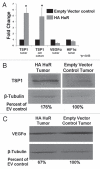Overexpression of the RNA binding protein HuR impairs tumor growth in triple negative breast cancer associated with deficient angiogenesis
- PMID: 20724828
- PMCID: PMC3041167
- DOI: 10.4161/cc.9.16.12711
Overexpression of the RNA binding protein HuR impairs tumor growth in triple negative breast cancer associated with deficient angiogenesis
Abstract
Interactions between RNA binding proteins (RBPs) and genes are not well understood, especially in regulation of angiogenesis. The RBP HuR binds to the AU-rich (ARE) regions of labile mRNAs, facilitating their translation into protein and has been hypothesized to be a tumor-maintenance gene. Elevated levels of cytoplasmic HuR directly correlate with increased invasiveness and poor prognosis for many cancers, including those of the breast. HuR controls the expression of multiple genes involved in angiogenesis including VEGFα, HIF1α and thrombospondin 1 (TSP1). We investigated the role of HuR in estrogen receptor negative (ER(-)) breast cancer. MDA-MB-231 cells with higher levels of HuR have alterations in cell cycle kinetics and faster growth. Unexpectedly, HuR overexpression significantly interfered with tumor growth in orthotopic mouse models. The putative mechanism seems to be an anti-angiogenetic effect by increasing expression of TSP1 but also surprisingly, downregulating VEGF, a target which HuR normally increases. Our findings reveal that HuR may be regulating a cluster of genes involved in blood vessel formation which controls tumor angiogenesis. An approach of modulating HuR levels may overcome limitations associated with monotherapies targeting tumor vessel formation.
Figures





Similar articles
-
The RNA binding protein HuR differentially regulates unique subsets of mRNAs in estrogen receptor negative and estrogen receptor positive breast cancer.BMC Cancer. 2010 Apr 6;10:126. doi: 10.1186/1471-2407-10-126. BMC Cancer. 2010. PMID: 20370918 Free PMC article.
-
Post-transcriptional gene regulation by HuR promotes a more tumorigenic phenotype.Oncogene. 2008 Oct 16;27(47):6151-63. doi: 10.1038/onc.2008.215. Epub 2008 Jul 21. Oncogene. 2008. PMID: 18641687 Free PMC article.
-
Cytoplasmic accumulation of the RNA binding protein HuR is central to tamoxifen resistance in estrogen receptor positive breast cancer cells.Cancer Biol Ther. 2008 Sep;7(9):1496-506. doi: 10.4161/cbt.7.9.6490. Epub 2008 Sep 23. Cancer Biol Ther. 2008. PMID: 18769129
-
HuR, a key post-transcriptional regulator, and its implication in progression of breast cancer.Histol Histopathol. 2010 Oct;25(10):1331-40. doi: 10.14670/HH-25.1331. Histol Histopathol. 2010. PMID: 20712017 Review.
-
HuR as a molecular target for cancer therapeutics and immune-related disorders.Adv Drug Deliv Rev. 2022 Sep;188:114442. doi: 10.1016/j.addr.2022.114442. Epub 2022 Jul 8. Adv Drug Deliv Rev. 2022. PMID: 35817212 Free PMC article. Review.
Cited by
-
Incisional hernia recurrence through genomic profiling: a pilot study.Hernia. 2013 Apr;17(2):193-202. doi: 10.1007/s10029-012-0923-4. Epub 2012 May 31. Hernia. 2013. PMID: 22648066 Free PMC article.
-
PKM2 uses control of HuR localization to regulate p27 and cell cycle progression in human glioblastoma cells.Int J Cancer. 2016 Jul 1;139(1):99-111. doi: 10.1002/ijc.30041. Epub 2016 Mar 2. Int J Cancer. 2016. PMID: 26874904 Free PMC article.
-
Micro-RNAs as clinical biomarkers and therapeutic targets in breast cancer: Quo vadis?World J Clin Oncol. 2014 May 10;5(2):71-81. doi: 10.5306/wjco.v5.i2.71. World J Clin Oncol. 2014. PMID: 24829853 Free PMC article. Review.
-
Ras/Raf/MEK/ERK and PI3K/PTEN/Akt/mTOR cascade inhibitors: how mutations can result in therapy resistance and how to overcome resistance.Oncotarget. 2012 Oct;3(10):1068-111. doi: 10.18632/oncotarget.659. Oncotarget. 2012. PMID: 23085539 Free PMC article. Review.
-
Analysing a Novel RNA-Binding-Protein-Related Prognostic Signature Highly Expressed in Breast Cancer.J Healthc Eng. 2021 Oct 18;2021:9174055. doi: 10.1155/2021/9174055. eCollection 2021. J Healthc Eng. 2021. Retraction in: J Healthc Eng. 2023 Oct 4;2023:9792854. doi: 10.1155/2023/9792854. PMID: 34707800 Free PMC article. Retracted.
References
-
- Reis-Filho JS, Tutt AN. Triple negative tumours: a critical review. Histopathology. 2008;52:108–118. - PubMed
-
- Deng S, Calin GA, Croce CM, Coukos G, Zhang L. Mechanisms of microRNA deregulation in human cancer. Cell Cycle. 2008;7:2643–2646. - PubMed
-
- Esquela-Kerscher A, Slack FJ. Oncomirs—microRNAs with a role in cancer. Nat Rev Cancer. 2006;6:259–269. - PubMed
Publication types
MeSH terms
Substances
Grants and funding
LinkOut - more resources
Full Text Sources
Other Literature Sources
Medical
Miscellaneous
